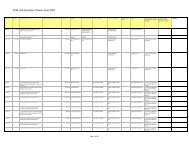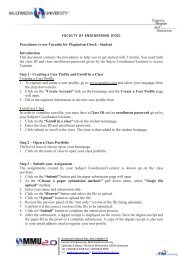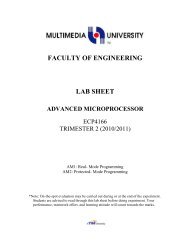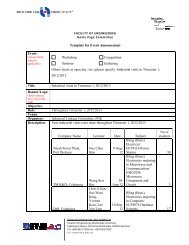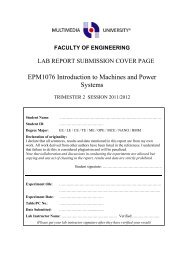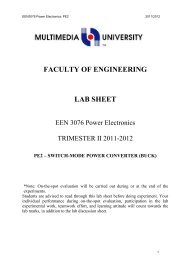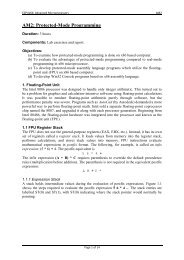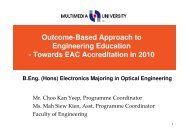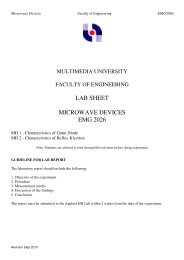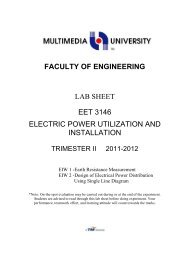EEN1016 Electronics I - Faculty of Engineering - Multimedia University
EEN1016 Electronics I - Faculty of Engineering - Multimedia University
EEN1016 Electronics I - Faculty of Engineering - Multimedia University
You also want an ePaper? Increase the reach of your titles
YUMPU automatically turns print PDFs into web optimized ePapers that Google loves.
<strong>EEN1016</strong> <strong>Electronics</strong> I: Appendices<br />
Consider a silicon diode that is connected in series with a 1 kΩ resistor, as shown in<br />
Figure 3. When a battery voltage <strong>of</strong> 3 V is applied, the diode is forward-biased and an electric<br />
current will start to flow in both the diode and the resistor. The voltage across the resistor will<br />
rise to a value V R = I×R which is slightly lower than 2.4 V. The current is limited to 2.4 mA<br />
(= 2.4 V/1 kΩ). This voltage will not rise above 2.4 V because otherwise the voltage across<br />
the diode will become lower than 0.6 V, which will then put the diode into a “high<br />
resistance” state that will allow only a very small current to flow in the circuit. Therefore, in<br />
the analysis <strong>of</strong> a diode circuit, we can usually assume the voltage across a silicon diode to be<br />
0.6 V, provided that the voltage source in the circuit is higher than 0.6 V and the polarity is to<br />
bias the diode in the forward direction (forward biased). The diode acts like a switch that is<br />
turned on. If the polarity is reversed, the diode will be reverse-biased and no current can flow<br />
in the circuit. In this condition, the diode acts like a switch that is turned <strong>of</strong>f. As a result, the<br />
voltage across the resistor will become zero (since I = 0).<br />
3V<br />
0.6V<br />
+ -<br />
I<br />
Figure 3<br />
1 kΩ<br />
+<br />
-<br />
V R<br />
Due to the unidirection characteristic <strong>of</strong> the device, a diode can be configured as a<br />
rectifier that allows current flow for only half a cycle <strong>of</strong> an AC waveform. A half-wave<br />
rectifier circuit is shown in Figure 4. When the potential at point A is more positive than that<br />
at point B, i.e. the supply voltage V S is positive, the diode is forward-biased. The voltage<br />
across the resistor will have the same waveform as the supply voltage V S (minus away 0.6V,<br />
to be exact). In the second half cycle, the voltage at A becomes negative, so the diode is<br />
reverse-biased. The voltage across the resistor will be zero throughout this half cycle. As a<br />
result, a half-wave waveform is obtained at the resistor. As the current flows only in the X-to-<br />
Y direction, therefore a direct current is obtained from the AC source.<br />
AC voltage<br />
A<br />
B<br />
+<br />
V S<br />
-<br />
v<br />
X<br />
+ V m<br />
R V o<br />
-<br />
Y φ<br />
Figure 4<br />
π<br />
V S<br />
V o<br />
2 π<br />
ω t<br />
Since the above diode circuit operates only for half a cycle, the efficiency is low. A<br />
bridge-rectifier circuit constructed using 4 diodes, as shown in Figure 5, can be used to<br />
double the efficiency. In the first half cycle <strong>of</strong> an AC waveform, diodes D1 and D2 are turned<br />
on while D3 and D4 are <strong>of</strong>f. Current flows from X to Y. In the second half cycle, when the<br />
potential at point B is more positive than point A, diode D3 and D4 are on while D1 and D3<br />
are turned <strong>of</strong>f. Current flows from X to Y again. Since there is always a current flow during<br />
both the positive cycle and the negative cycle, a rectified full-wave waveform is obtained, as<br />
<strong>Faculty</strong> <strong>of</strong> <strong>Engineering</strong>, <strong>Multimedia</strong> <strong>University</strong> Page 2



